Arts Preview: International art invades the suburban Coachella Valley: The best of ‘Desert X’
In January, prosecutors in Riverside filed 30 felony charges against two longtime Palm Springs developers and a former mayor in an alleged $375,000 bribery scheme related to building projects downtown.
Ah, the romance of the desert! A place of fierce natural beauty and beguiling spiritual wonder! A rejuvenating refuge from the crushing pressures of modern urban life!
“Desert X,” the ambitious exhibition of new site-specific art installations scattered around the Coachella Valley, is successful partly because the 16 participating artists mostly skirt romanticized desert clichés — or else they engage them, casting a skeptical or parodic eye. Perhaps surprisingly, none chose to consider the springs that made this corner of the desert bloom; but many works burrow into the area’s complex history and heterogeneous present.
In Coachella, the easternmost town in the valley, Armando Lerma has painted a big, charming mural on the side of a modest neighborhood ice cream shop. Titled “The Party in the Desert,” its amiable rural imagery of clowns, a juggler, a table laden with cake and bowls of fruit, assorted revelers, a starburst piñata, some chickens and a couple of dogs, unfolds its narrative slowly.
FULL COVERAGE: Spring arts guide 2017

Lerma’s chosen site on a scruffy industrial strip along railroad tracks looks back to the town’s founding almost a century and a half ago as a siding for the Southern Pacific Railroad. The locale’s modesty reflects the working-class identity of a rough-edged town where more than a quarter of residents live below the poverty line.
Look closely, and the mural sports several small medallions of the Virgin of Guadalupe, saint and protector. In a wry gesture, they are affixed to the wall at places where metal bolts protrude, signaling earthquake retrofitting. Fiesta connects the ice cream store with the town’s largely Latino local population.
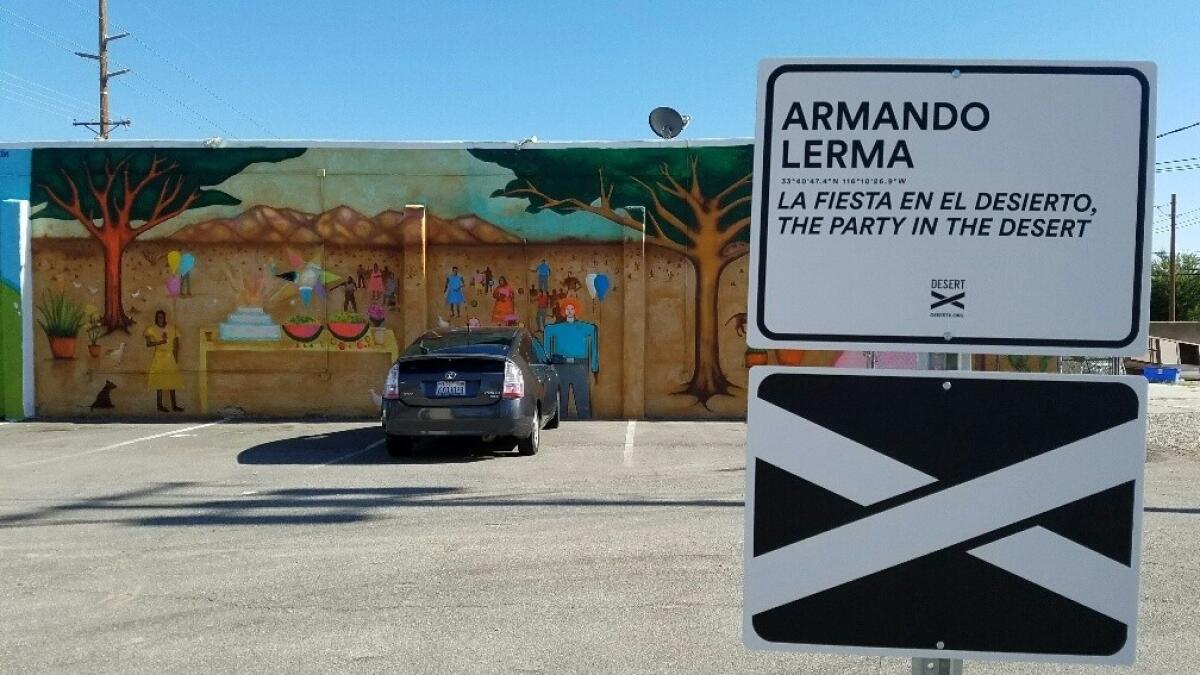
Perhaps the mural’s most vital feature is its implied but incisive contrast to that other local “party in the desert” — the raucous, corporately produced, hugely profitable Coachella Valley Music and Arts Festival that annually invades the area just up the street in Indio, where the artist was born. Lerma grounds his marvelous mural in the routine social realities of place, yet without so much as a hint of critical disdain for what is finally just a different way for revelers to paint the town.
Twenty-eight miles away in Palm Springs, near the westernmost end of the valley, Mexican artist Gabriel Kuri, who lives and works in Los Angeles and Brussels, has brought a chunk of desert indoors. For “Donation Box,” he’s filled half a storefront in a down-on-its-heels mini-mall at the edge of town with a deep layer of sand, piled into a desolate landscape of gently rolling dunes.
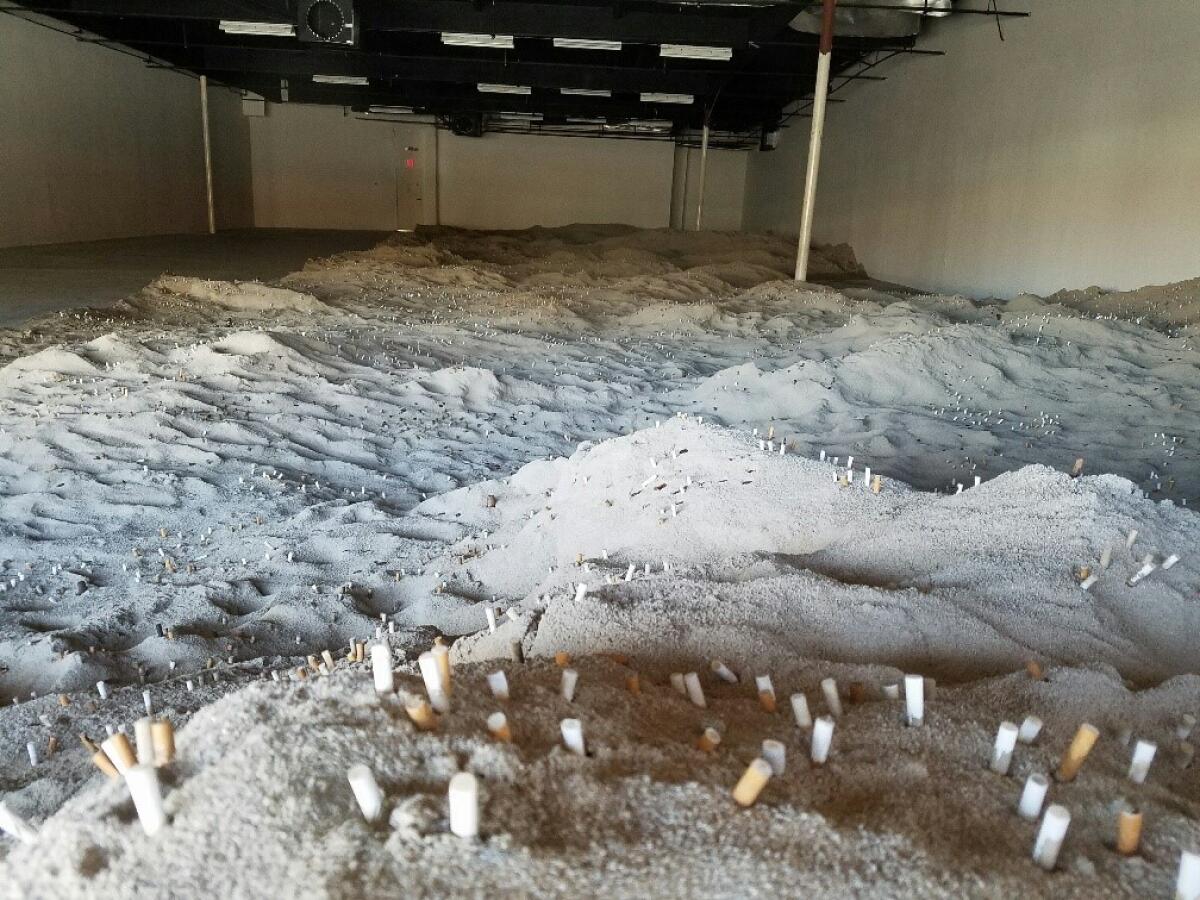
Peering through the plate-glass window, you’ll see hundreds of cigarette butts stuck in the sand, along with casually tossed coins. It loosely recalls Damien Hirst’s giant ashtray sculptures, with their aura of forlorn grandiloquence, plus Chris Burden’s monumental city-in-the-sand sculpture, “A Tale of Two Cities,” assembled from toys. Kuri’s is a grunge wishing well, radiating boom-and-bust.
Zigzagging across the region during the two days necessary to see all of “Desert X,” I put more than 175 miles on my odometer. (A free guidebook and map with GPS coordinates are available in the lobby of Ace Hotel & Swim Club on East Palm Canyon Drive in Palm Springs.) The physical distance between Lerma’s mural and Kuri’s sculpture is fitting for the sprawl that characterizes both the raw desert and its fitful development since the 1960s. The valley, once a string of villages, is primarily suburban now.
Indeed, the graphic logo for the show’s title draws the X like a crossing sign. Desert Crossing is the name of a mid-valley shopping center.
The artists were selected by Neville Wakefield, 54, former curator of Frieze Projects, a program of artists’ commissions that is part of the Frieze Art Fair in London, and past advisor to PS1, the Long Island City affiliate of New York’s Museum of Modern Art. Most “Desert X” commissions are clustered in Palm Springs and Rancho Mirage, but other projects are farther afield.
In the remote, drop-dead gorgeous landscape of the Whitewater Preserve, a bit more than five miles into rugged canyon country north of the 10 Freeway, L.A.-based Sherin Guirguis transformed sandbags, tree limbs and mud into an elegant, hive-shaped dovecote. The structure, based on pigeon towers commonly found in desert villages of her native Egypt, is a cross-cultural emblem of displacement and shelter.
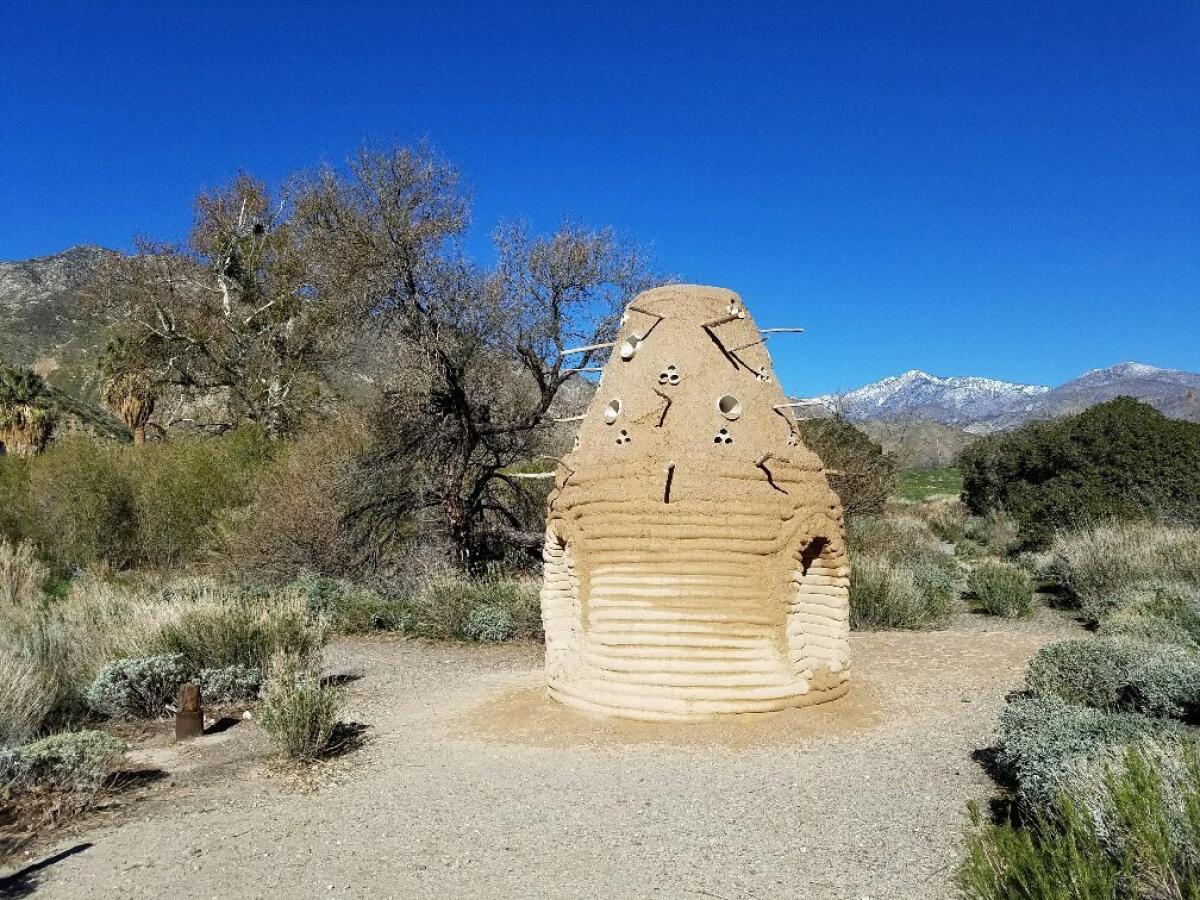
So is Richard Prince’s grim installation, albeit of a wholly different character, in a disheveled quarter of nearby Desert Hot Springs. The ramshackle walls and surroundings of an abandoned hacienda-style house are plastered with printed blowups of sordid Twitter feeds that the artist scavenged for tales of banal indulgences in sex, drugs and rock ’n’ roll.
In keeping with the derelict domesticity of the work’s forlorn site, Prince focuses on vulgar tweets by and about dysfunctional families — sisters, cousins, mothers and aunts. Voyeuristic trash gets tangled like litter in desert scrub.
According to an exhibition spokesman, the unsecured site has already been vandalized and several works looted from the house. Unsurprising, perhaps, for an artist whose queasy paintings of naughty nurses — soft-porn imagery where nurture precedes betrayal — have sold in the seven figures. But vandalism’s crude delinquency merely serves to italicize Prince’s theme. Like Twitter, the installation makes hitherto secret vices brazenly public; vanity grates against shame.
Two artists — Glenn Kaino and Will Boone — have burrowed into the ground. Both view the desert as an ancient, wide-open expanse harboring topical secrets.
Kaino’s “Hollow Earth” is an ordinary storage shed set out in a bland field. Open the door, go inside and in the center of a small room lined in cheap fiberboard is a seemingly bottomless shaft ringed by a circular white grid that glows with a bluish light. A pristine infinity pit, it elicits playful childhood fantasies of tunneling all the way to China crossed with grown-up fears of sinister silos harboring the tools of Armageddon.
Speaking of bomb shelters, Boone built one beneath another dusty field. Clamber down a ladder, pass through a heavy steel door and enter a tubular metal shelter like a big sewer pipe. There sits a bulky bronze sculpture of President Kennedy, decorously painted red, white and blue, as if some pharaonic potentate buried in the sands of time.
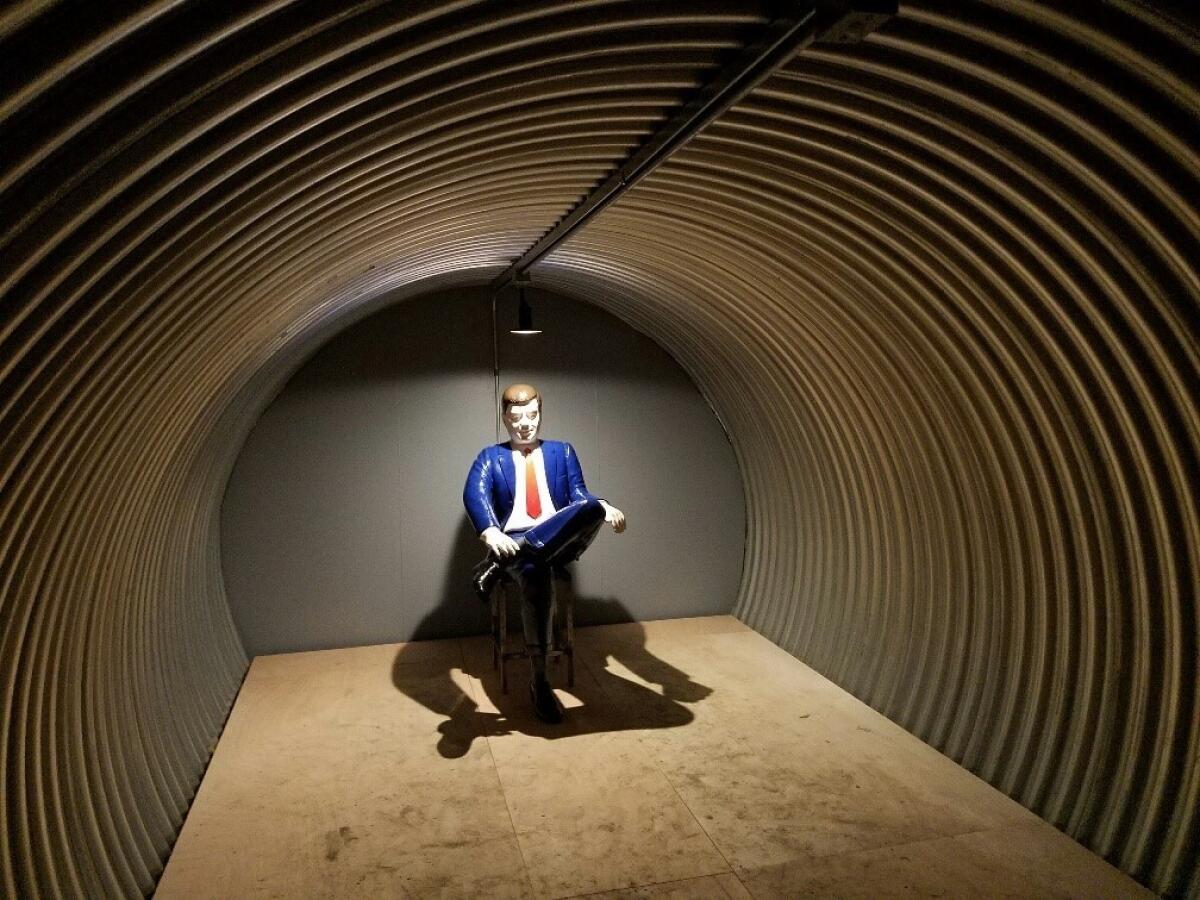
Illuminated from overhead by a single, solar-powered bulb, the seated dignitary is both a Lincoln-like “Monument,” as the installation is titled, and a suspect ready for interrogation. The conundrum befits a national hero whose life and death are the subject of endless conspiracy theories. He’s the hidden love-match to Marilyn Monroe, whose likeness is plastered all over Palm Springs as an emblem of its midcentury Hollywood playground past.
Back above ground, two other artists have built walls. Both are Minimalist and hallucinatory.
Phillip K. Smith III, who gained acclaim four years ago for wrapping a remote desert shack with mirrored strips that made it seem on the verge of disappearing into Joshua Tree’s rugged landscape, is here with more mirror-play. This time he has crafted a big, bowl-shaped arena, 70 paces across and composed from scores of tall mirrored rods set up in a circle.
Canted outward on a 10-degree angle, the exterior reflects the earth back onto itself. The bowl’s interior reflects sky, incongruously surrounding an earthbound viewer. From both vantages the actual landscape is simultaneously seen between the shiny reflective bars. Normality alternates with a routine order of things that’s been flipped on its head.
Near the base of a hiking trial, Swiss artist Claudia Comte has built a long, tall, undulating concrete wall. Its horizontal form slowly morphs from gentle curves at one end to an angular zigzag at the other. Comte has matched this brute material form with the same sequence of purely visual shapes — vertical black stripes set against a blazing white ground, starting with rippling waves and ending with jagged lines.
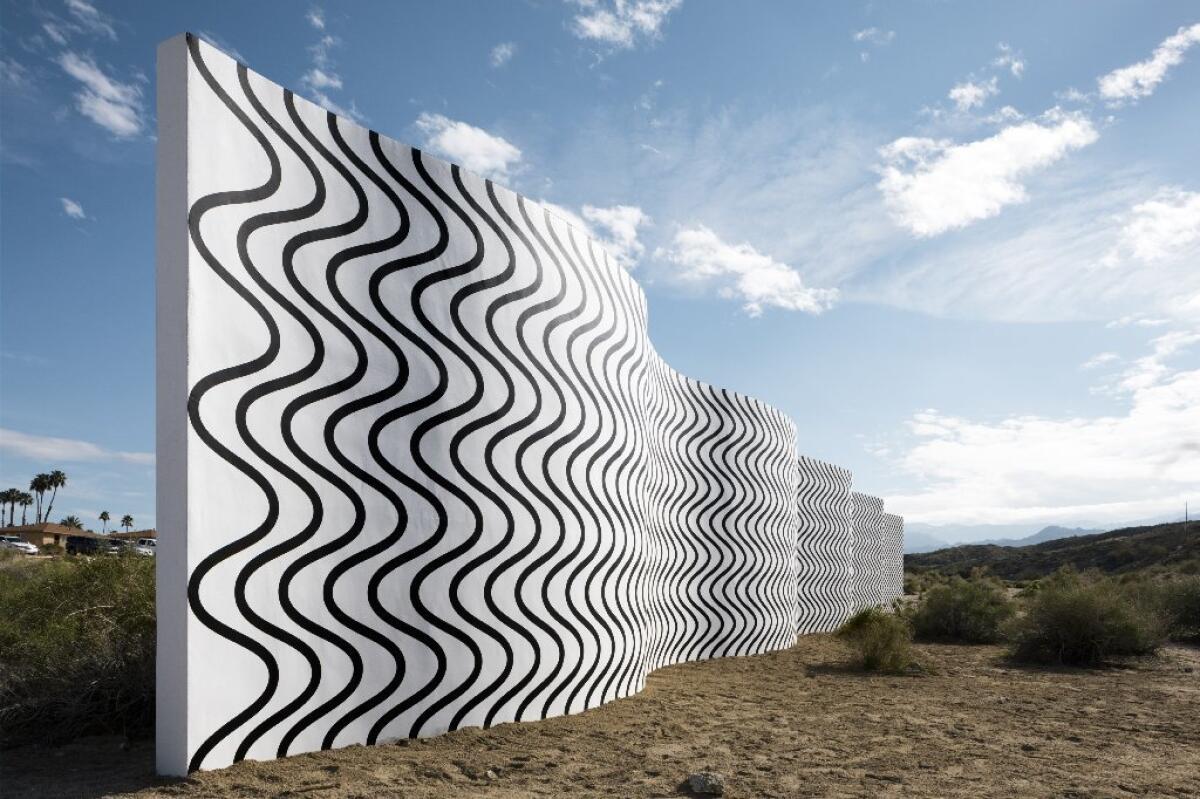
Like rising waves of desert heat that lead one to delirium and back, the effect is surprisingly powerful. Sol LeWitt’s rigor mixes with Bridget Riley’s verve. Minimalist Op art is rarely this good.
Illusion is likewise key to Jennifer Bolande’s head-turning set of three double-sided billboards along the west side of Gene Autry Trail, a road leading in and out of the valley from the freeway. Bolande photographed the distant San Jacinto, Santa Rosa and San Bernardino mountain ranges, then enlarged the images to billboard scale. For one fleeting, disconcerting moment as you drive by, the wordless pictures line up exactly with the approaching view.
While the mountain contours match up precisely, the clarity, color and light inevitably do not. The quick drive-by sequence of three billboard moments is so brief that you can’t quite be certain of what you have just witnessed.
It’s like a flash-cut in a motion picture, subliminal in effect. A disjunction between image and reality is lodged in a path named for a half-forgotten cowboy star of movies and TV. The seamless fabric of experience gets torn.

Additional projects by Doug Aitken, Lita Albuquerque, Jeffrey Gibson, Norma Jeane, Rob Pruitt, Julião Sarmento and Tavares Strachan are also on view. The show is being seen as an art world answer to the wildly successful Coachella music festival, beginning April 14. (“Desert X,” continuing through April 30, overlaps with it.) While that connection makes marketing sense, in spirit the endeavor is more like a suburban version of the urban “Sculpture Projects Münster,” a once-per-decade exhibition of commissioned public art throughout the German city.
The “Münster” show, opening its fifth iteration in June, is among Europe’s most reliably engaging art events. “Desert X” organizers hope to mount their own sequel — an excellent idea, given the overall artistic success of this one, although not yet certain.
If a serious flaw mars this otherwise admirable event, it is the sharp gender disparity in the current lineup. In 2017, no excuse is good enough for inviting only four women to participate among 16 artists. (An irony: The area’s first major artist was transcendentalist painter Agnes Pelton, who arrived in Cathedral City in 1932.) If “Desert X 2.0” does take place, the unforced error represents an easy fix.
♦ ♦ ♦ ♦ ♦ ♦ ♦ ♦ ♦ ♦
‘Desert X’
Where: Various sites in the Coachella Valley; guidebook and map at Ace Hotel, 701 E. Palm Canyon Drive, Palm Springs
When: Through April 30
Information: www.desertx.org
christopher.knight@latimes.com
Twitter: @KnightLAT
See our complete guide to spring arts events in L.A.
ALSO
Why Iceland? L.A. Phil's Reykjavik Festival highlights amazing music coming from an unlikely place
At Richard Telles Fine Art, Jim Isermann's illusions stack up
Diego Rivera's Cubist masterpiece arrives at LACMA
The biggest entertainment stories
Get our big stories about Hollywood, film, television, music, arts, culture and more right in your inbox as soon as they publish.
You may occasionally receive promotional content from the Los Angeles Times.




